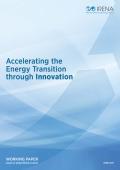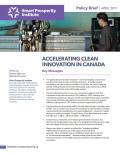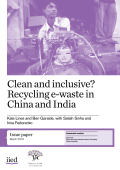

The world needs a decarbonised energy sector by the second half of the century. In many energy applications, the necessary technologies are available today, so the important next step is the development of enabling policy frameworks in place to scale up their deployment. There are however energy demands in end-use sectors that are responsible for a third of the emissions in the Reference Case in 2050 – the baseline of this study, where several technology options are emerging but are yet to reach their economic and technical viability.
This working paper aims to shed light on the conditions needed to nurture low-carbon technology innovation. By assessing current status and future needs for such technologies, it seeks to identify the elements of a flexible policy framework for innovation, broadly suitable to enable decarbonisation of the energy sector between now and 2050. The envisaged of cultivation of effective, case-specific innovation policies would do much to help countries meet international climate goals, such as those set forth in the 2015 Paris Agreement.

This report, the first international assessment of this type, investigates the life-cycle environmental and natural resource implications of large-scale deployment of energy efficiency technologies. The report examines more than 30 demand-side energy efficiency technologies across different technological clusters, including lighting, buildings, information and communication technology, efficient metals processing, high-efficiency cogeneration, and transportation. In addition, the combined effects of low-carbon energy supply and deployment of efficient demand-side technologies under the 2 degree and 6 degree Celsius scenarios are assessed. Research confirms that demand-side technologies reduce greenhouse gas emissions as well as many other environmental impacts. However, the magnitude of those improvements varies widely among technologies and regions. In some cases, demand-side technologies may increase resource consumption and even greenhouse gas emissions. Therefore, it is crucial to understand where, when, and with which technology investment should be placed to maximise benefits.

The global demand for clean innovation – new technologies, products and practices that improve environmental performance – is rapidly growing. Accelerating the pace of clean innovation in Canada is not only an important tool for meeting climate and environmental goals, it also represents a critical economic opportunity across all Canadian sectors.
Canada’s cleantech sector can tap into a fast-growing global market that is expected to be worth as much as C$2.5 trillion by 2020. Resource and manufacturing sectors can also gain market advantage through clean innovation. For example, McKinsey estimates that improvements in energy and resource efficiency will represent a C$3.8 trillion economic opportunity by 2030.
This research initiative seeks to define the clean innovation opportunity, evaluate the strengths and weaknesses of Canada's performance, and to identify the key opportunities for public and private actors to accelerate the pace of clean innovation.

E-waste – electrical and electronic waste – is one of today’s fastest growing waste streams. By managing it well, we can recover valuable raw materials and reusable parts, with significant associated emissions savings. But much of its potential is lost when incorrectlly processed by informal and unregulated enterprises. This can damage both people’s health and the environment and intensify the vulnerability of workers.
Informal markets are where most of the world’s poor produce, consume and trade goods. Using case studies from China and India – both with huge informal e-waste sectors – this paper explores how to build inclusive, greener economies that retain the benefits of informal markets, while addressing how and why people are excluded from formal activities. Both countries are stepping up efforts to regulate but are failing to take into account the importance of engaging with the informal e-waste sector. How can drives to clean up harmful practices take their experience and expertise into account? And how can we develop effective policies to tackle pollution while supporting the health, livelihoods and economic activities of the poor and vulnerable?
